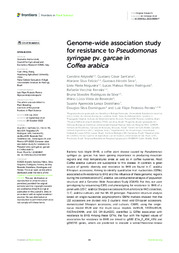Genome-wide association study for resistance to Pseudomonas syringae pv. garcae in Coffea arabica.
Genome-wide association study for resistance to Pseudomonas syringae pv. garcae in Coffea arabica.
Autoria: ARIYOSHI, C.; SANT'ANA, G. C.; FELICIO, M. S.; SERA, G. H.; NOGUEIRA, L. M.; RODRIGUES, L. M. R.; FERREIRA, R. V.; SILVA, B. S. R. da; RESENDE, M. L. V. de; DESTÉFANO, S. A. L.; DOMINGUES, D. S.; PEREIRA, L. F. P.
Resumo: Bacteria halo blight (BHB), a coffee plant disease caused by Pseudomonas syringae pv. garcae, has been gaining importance in producing mountain regions and mild temperatures areas as well as in coffee nurseries. Most Coffea arabica cultivars are susceptible to this disease. In contrast, a great source of genetic diversity and resistance to BHB are found in C. arabica Ethiopian accessions. Aiming to identify quantitative trait nucleotides (QTNs) associated with resistance to BHB and the influence of these genomic regions during the domestication of C. arabica, we conducted an analysis of population structure and a Genome-Wide Association Study (GWAS). For this, we used genotyping by sequencing (GBS) and phenotyping for resistance to BHB of a panel with 120 C. arabica Ethiopian accessions from a historical FAO collection, 11 C. arabica cultivars, and the BA-10 genotype. Population structure analysis based on single-nucleotide polymorphisms (SNPs) markers showed that the 132 accessions are divided into 3 clusters: most wild Ethiopian accessions, domesticated Ethiopian accessions, and cultivars. GWAS, using the single-locus model MLM and the multi-locus models mrMLM, FASTmrMLM, FASTmrEMMA, and ISIS EM-BLASSO, identified 11 QTNs associated with resistance to BHB. Among these QTNs, the four with the highest values of association for resistance to BHB are linked to g000 (Chr_0_434_435) and g010741 genes, which are predicted to encode a serine/threonine-kinase protein and a nucleotide binding site leucine-rich repeat (NBS-LRR), respectively. These genes displayed a similar transcriptional downregulation profile in a C. arabica susceptible cultivar and in a C. arabica cultivar with quantitative resistance, when infected with P. syringae pv. garcae. However, peaks of upregulation were observed in a C. arabica cultivar with qualitative resistance, for both genes. Our results provide SNPs that have potential for application in Marker Assisted Selection (MAS) and expand our understanding about the complex genetic control of the resistance to BHB in C. arabica. In addition, the findings contribute to increasing understanding of the C. arabica domestication history.
Ano de publicação: 2022
Tipo de publicação: Artigo de periódico
Unidade: Embrapa Café
Palavras-chave: Coffea Arábica, Disease resistance, Genome, Genome-wide association study, Pseudomonas syringae group
Observações
1 - Por padrão são exibidas publicações dos últimos 20 anos. Para encontrar publicações mais antigas, configure o filtro ano de publicação, colocando o ano a partir do qual você deseja encontrar publicações. O filtro está na coluna da esquerda na busca acima.
2 - Para ler algumas publicações da Embrapa (apenas as que estão em formato ePub), é necessário ter, no celular ou computador, um desses softwares gratuitos. Sistemas Android: Google Play Livros; IOS: iBooks; Windows e Linux: software Calibre.
Acesse outras publicações
Acesse a Base de Dados da Pesquisa Agropecuária (BDPA) para consultar o acervo completo das bibliotecas da Embrapa.

